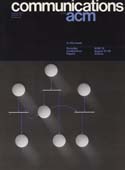August 1973 - Vol. 16 No. 8

Features
A learning program which plays partnership dominoes
A learning program has been written in BASIC to play four-player partnership dominoes. Because dominoes is a game of incomplete information, the program uses somewhat different principles of artificial intelligence from those used in programs for games of complete information, such as checkers, chess, and go. The program was constructed to use a “strategy signature table” which classifies board situations through the interactions of game parameters. Each entry in the table contains adaptively determined weights indicating the advisability of various strategies. Once chosen, a strategy then employs probability analysis and linear polynomial evaluation to choose a move. Our program wins approximately two-thirds of its games in tournament situations, and has defeated championship players.
Fen—an axiomatic basis for program semantics
A formal system is presented which abstracts the notions of data item, function, and relation. It is argued that the system is more suitable than set theory (or its derivatives) for the concise and accurate description of program semantics. It is shown how the system can be used to build composite data types out of simpler ones with the operations of rowing, structuring, and uniting. It is also demonstrated that completely new primitive types can be introduced into languages through the mechanism of singleton data types.
Both deterministic and nondeterministic functions are shown to be definable in the system. It is described how the local environment can be modeled as a data item and how imperative statements can be considered functions on the environment. The nature of recursive functions is briefly discussed, and a technique is presented by which they can be introduced into the system. The technique is contrasted with the use of the paradoxical combinator, Y. The questions of local and global environments and of various modes of function calling and parameter passing are touched upon.
The theory is applied to the proof of several elementary theorems concerning the semantics of the assignment, conditional, and iterative statements.
An appendix is included which presents in detail the formal system governing webs and fen, the abstractions used informally in the body of the paper.
Petri nets and speed independent design
Petri nets are investigated as one method of modeling speed independent asynchronous circuits. A study of circuit realizations of Petri nets leads to a demonstration of their usefulness in modeling speed independent operation. This usefulness is emphasized by the design of a speed independent processor from modules developed in the investigation of Petri net implementation.
Inductive methods for proving properties of programs
There are two main purposes in this paper: first, clarification and extension of known results about computation of recursive programs, with emphasis on the difference between the theoretical and practical approaches; second, presentation and examination of various known methods for proving properties of recursive programs. Discussed in detail are two powerful inductive methods, computational induction and structural induction, including examples of their applications.
On the capabilities of while, repeat, and exit statements
A well-formed program is defined as a program in which loops and if statements are properly nested and can be entered only at their beginning. A corresponding definition is given for a well-formed flowchart. It is shown that a program is well formed if and only if it can be written with if, repeat, and multi-level exit statements for sequence control. It is also shown that if, while, and repeat statements with single-level exit do not suffice. It is also shown that any flowchart can be converted to a well-formed flowchart by node splitting. Practical implications are discussed.
A generalization of AVL trees is proposed in which imbalances up to &Dgr; are permitted, where &Dgr; is a small integer. An experiment is performed to compare these trees with standard AVL trees and with balanced trees on the basis of mean retrieval time, of amount of restructuring expected, and on the worst case of retrieval time. It is shown that, by permitting imbalances of up to five units, the retrieval time is increased a small amount while the amount of restructuring required is decreased by a factor of ten.
A few theoretical results are derived, including the correction of an earlier paper, and are duly compared with the experimental data. Reasonably good correspondence is found.
0



